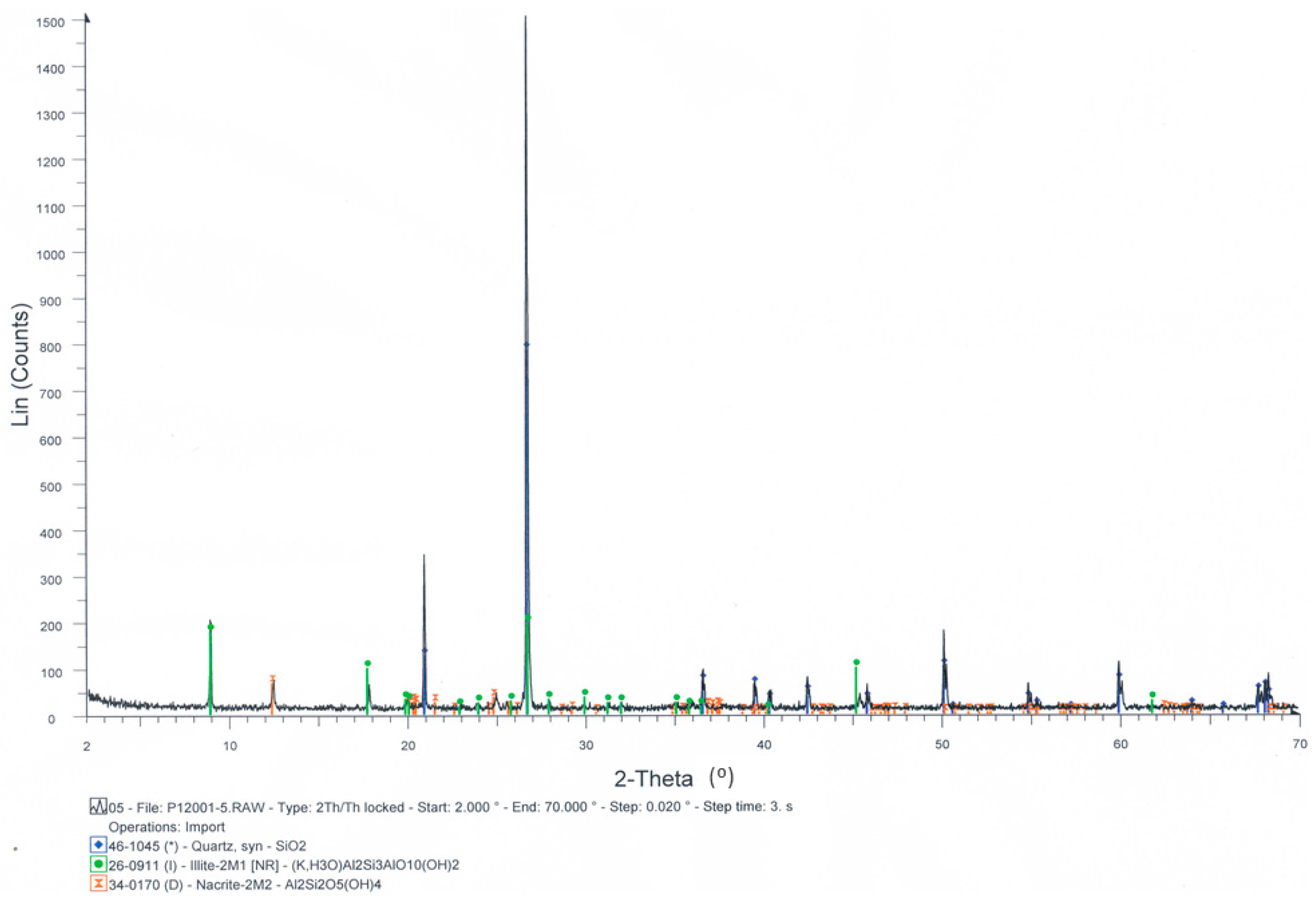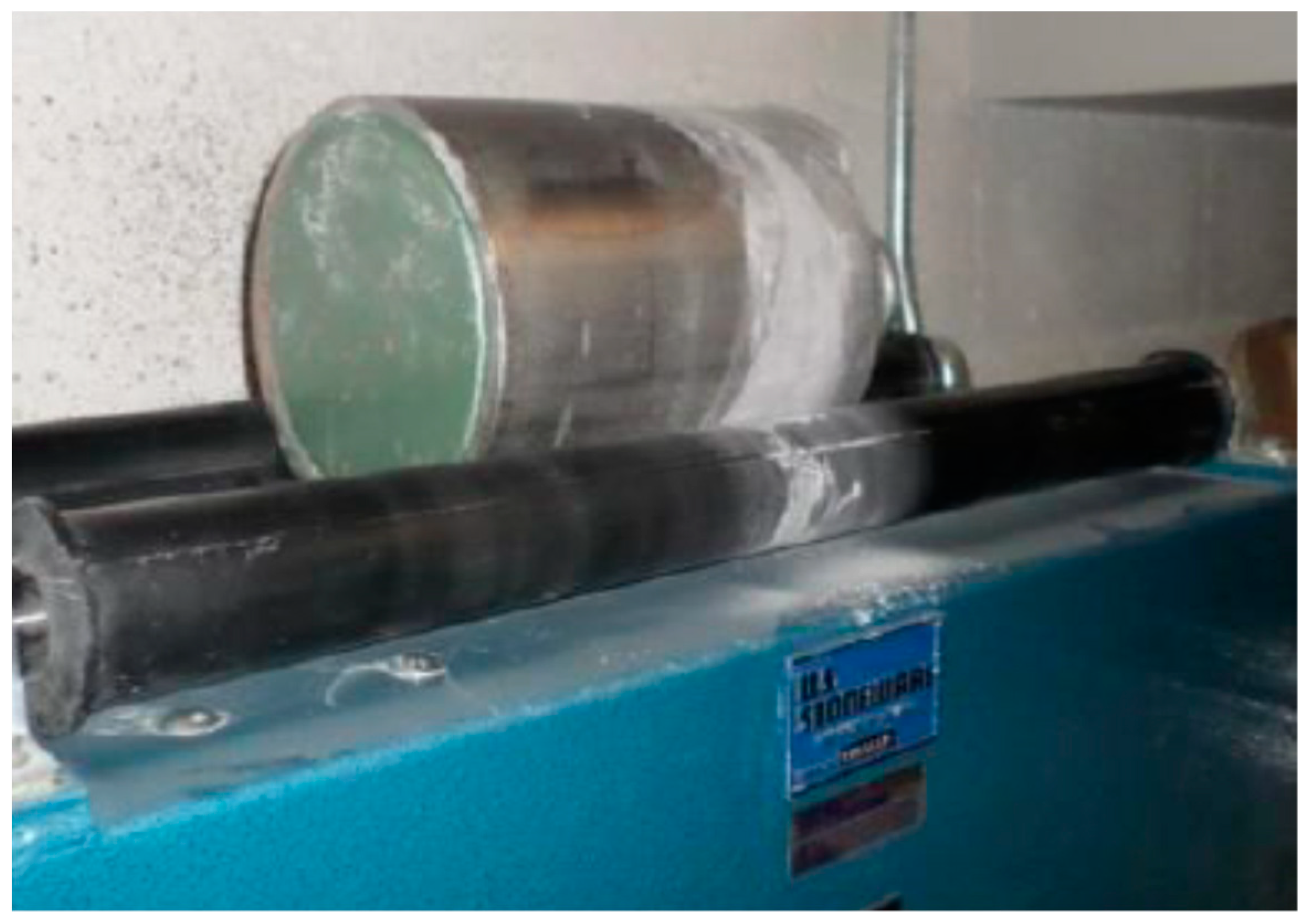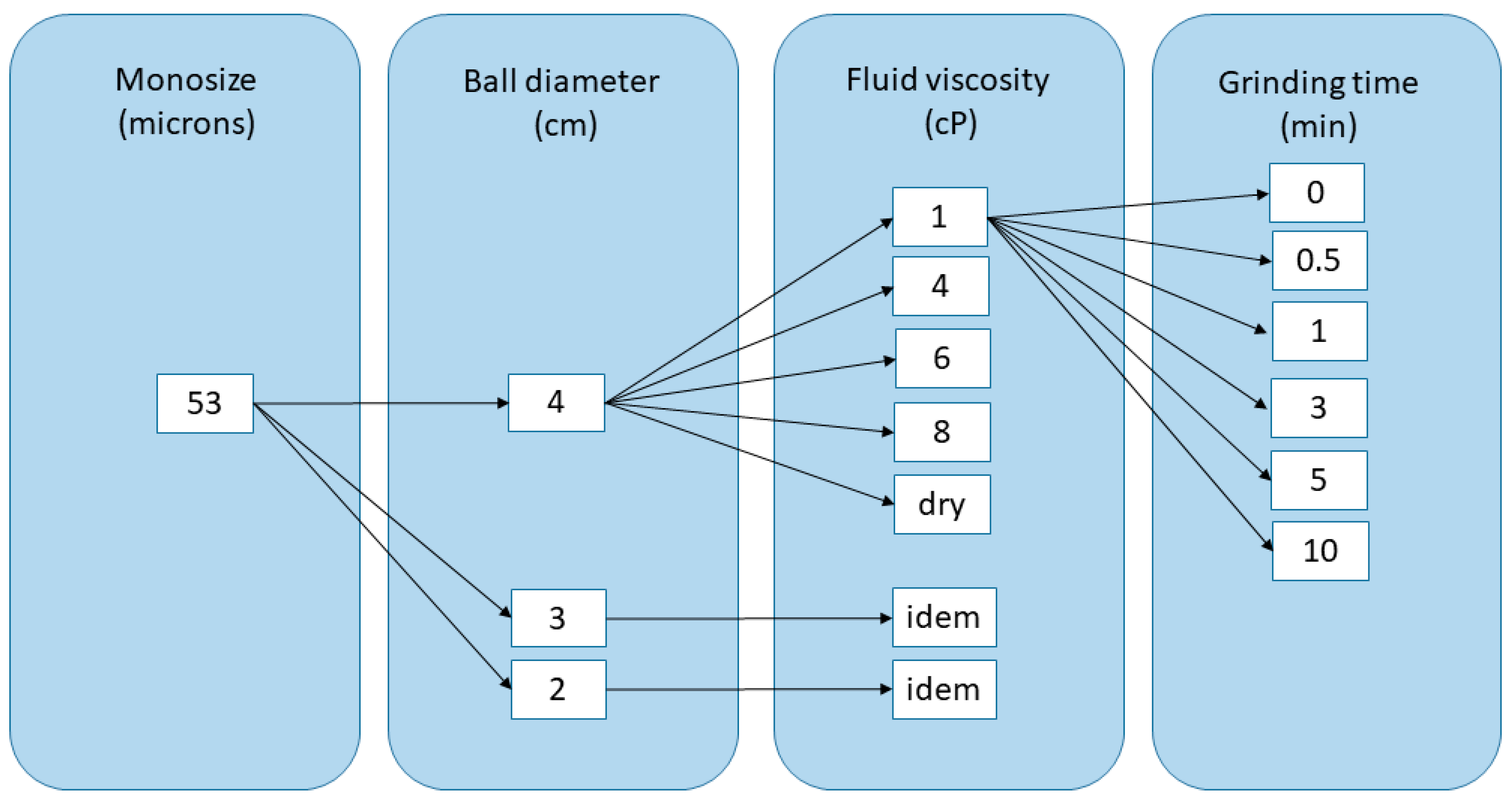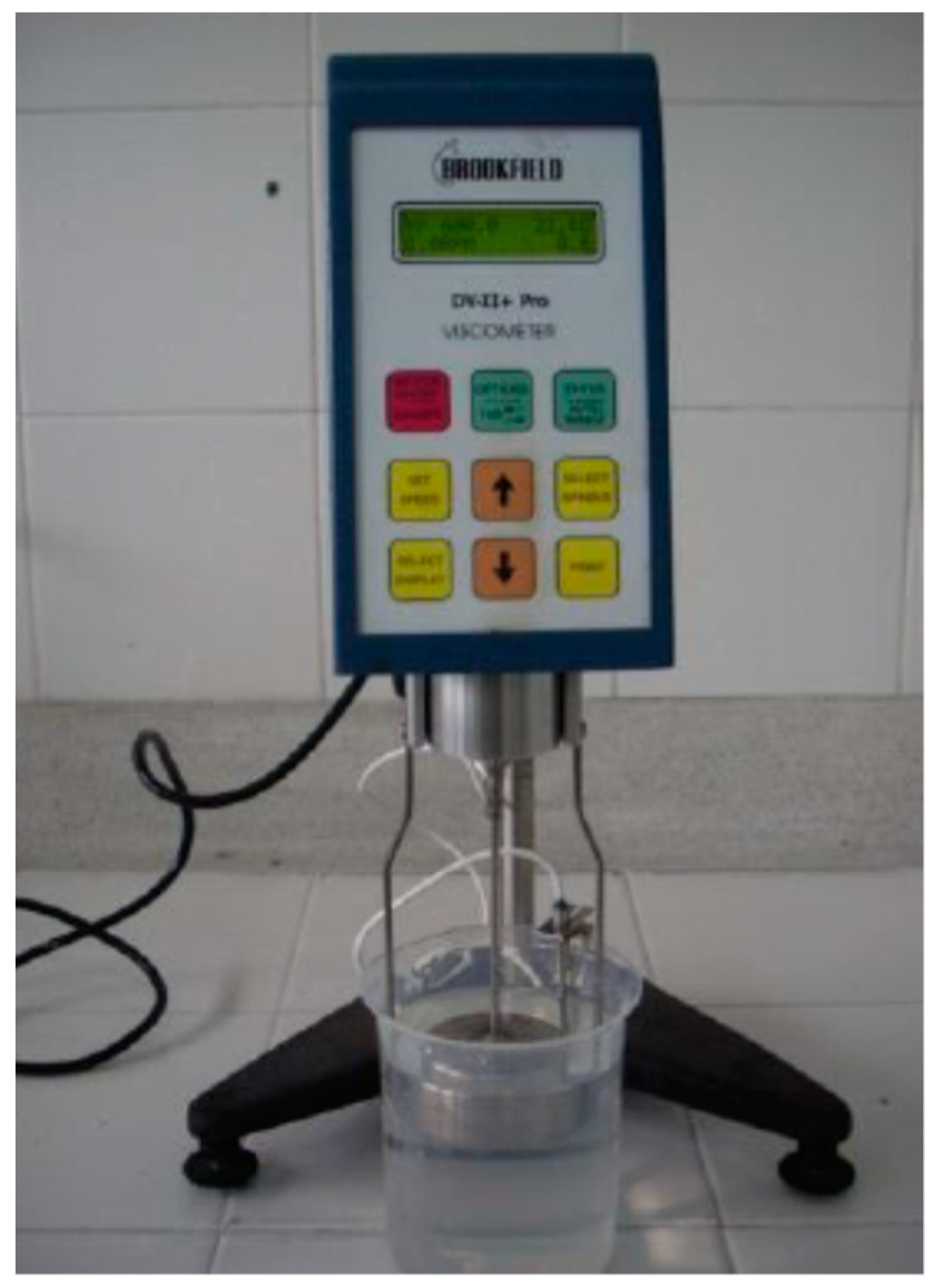A Study of the Effect of Medium Viscosity on Breakage Parameters for Wet Grinding
Abstract
:1. Introduction
2. Methodology
2.1. Materials
2.2. Methods
- viscosity of the suspending fluid, μl;
- viscosity of the suspension, μs;
- particle diameter, dp;
- density of the grinding media, ρb.
3. Results and Discussion
4. Conclusions
Author Contributions
Funding
Acknowledgments
Conflicts of Interest
References
- Coello Velázquez, A.L.; Menéndez-Aguado, J.M.; Brown, R.L. Grindability of lateritic nickel ores in Cuba. Powder Technol. 2008, 182, 113–115. [Google Scholar] [CrossRef]
- Aguado, J.M.M.; Velázquez, A.L.C.; Tijonov, O.N.; Díaz, M.A.R. Implementation of energy sustainability concepts during the comminution process of the Punta Gorda nickel ore plant (Cuba). Powder Technol. 2006, 170, 153–157. [Google Scholar] [CrossRef]
- Umucu, Y.; Altınigne, M.Y.; Deniz, V. The effects of ball types on breakage parameters of barite. J. Pol. Min. Eng. Soc. 2014, 15, 113–117. [Google Scholar]
- Zhang, W. Optimizing Performance of SABC Comminution Circuit of the Wushan Porphyry Copper Mine—A Practical Approach. Minerals 2016, 6, 127. [Google Scholar] [CrossRef]
- Liang, G.; Wei, D.; Xu, X.; Xia, X.; Li, Y. Study on the Selection of Comminution Circuits for a Magnetite Ore in Eastern Hebei, China. Minerals 2016, 6, 39. [Google Scholar] [CrossRef]
- Petrakis, E.; Komnitsas, K. Improved Modeling of the Grinding Process through the Combined Use of Matrix and Population Balance Models. Minerals 2017, 7, 67. [Google Scholar] [CrossRef]
- Mariño-Salguero, J.; Jorge, J.; Menéndez-Aguado, J.M.; Álvarez-Rodriguez, B.; De Felipe, J.J. Heat generation model in the ball-milling process of a tantalum ore. Miner. Metall. Process. 2017, 34, 10–19. [Google Scholar] [CrossRef]
- Pedrayes, F.; Norniella, J.G.; Melero, M.G.; Menéndez-Aguado, J.M.; del Coz-Díaz, J.J. Frequency domain characterization of torque in tumbling ball mills using DEM modelling: Application to filling level monitoring. Powder Technol. 2018, 323, 433–444. [Google Scholar] [CrossRef]
- Lee, H.; Kim, K.; Lee, H. Analysis of grinding kinetics in a laboratory ball mill using population-balance-model and discrete-element-method. Adv. Powder Technol. 2019. [Google Scholar] [CrossRef]
- Petrakis, E.; Stamboliadis, E.; Komnitsas, K. Identification of Optimal Mill Operating Parameters during Grinding of Quartz with the Use of Population Balance Modeling. KONA Powder Part. J. 2017, 34, 213–223. [Google Scholar] [CrossRef] [Green Version]
- Muster, T.H.; Prestidge, C.A. Rheological investigations of sulphide mineral slurries. Miner. Eng. 1995, 8, 1541–1555. [Google Scholar] [CrossRef]
- Klimpel, R.R. Slurry rheology influence on the performance of mineral/coal grinding circuits. Part I. Miner. Eng. 1982, 34, 1665–1688. [Google Scholar]
- Klimpel, R.R. Slurry rheology influence on the performance of mineral/coal grinding circuits. Part II. Miner. Eng. 1982, 35, 21–26. [Google Scholar]
- Ding, Z.; Yin, Z.; Liu, L.; Chen, Q. Effect of grinding parameters on the rheology of pyrite-heptane slurry in a laboratory stirred media mill. Miner. Eng. 2007, 20, 701–709. [Google Scholar] [CrossRef]
- Cruz, N.; Forster, J.; Bobicki, E.R. Slurry rheology in mineral processing unit operations: A critical review. Can. J. Chem. Eng. 2019, 97, 2102–2120. [Google Scholar] [CrossRef]
- Yin, Z.; Peng, Y.; Zhu, Z.; Ma, C.; Yu, Z.; Wu, G. Effect of mill speed and slurry filling on the charge dynamics by an instrumented ball. Adv. Powder Technol. 2019, 30, 1611–1616. [Google Scholar] [CrossRef]
- Barvenik, F.W. Polyacrylamide characteristics related to soil applications. Soil Sci. 1994, 158, 235–243. [Google Scholar] [CrossRef]
- Jung, J.; Jang, J.; Ahn, J. Characterization of a Polyacrylamide Solution Used for Remediation of Petroleum Contaminated Soils. Materials 2016, 9, 16. [Google Scholar] [CrossRef] [PubMed]
- Menéndez-Aguado, L.D.; Marina Sánchez, M.; Rodríguez, M.A.; Coello Velázquez, A.L.; Menéndez-Aguado, J.M. Recycled Mineral Raw Materials from Quarry Waste Using Hydrocyclones. Materials 2019, 12, 2047. [Google Scholar] [Green Version]
- Schild, H.G. Poly(N-isopropylacrylamide): Experiment. theory and application. Prog. Polym. Sci. 1992, 17, 163–249. [Google Scholar] [CrossRef]
- Nasser, M.S.; James, A.E. The effect of polyacrylamide charge density and molecular weight on the flocculation and sedimentation behaviour of kaolinite suspensions. Sep. Purif. Technol. 2006, 52, 241–252. [Google Scholar] [CrossRef]
- Langhaar, H.L. Dimensional Analysis and Theory of Models; Wiley: New York, NY, USA, 1951. [Google Scholar]
- Curtis, W.D.; David Logan, J.; Parker, W.A. Dimensional Analysis and the Pi Theorem. Linear Algebra Appl. 1982, 47, 117–126. [Google Scholar] [CrossRef]
- Pobedrya, B.E.; Georgievskii, D.V. On the proof of the Pi-Theorem in Dimension Theory. Russ. J. Math. Phys. 2006, 13, 431–437. [Google Scholar] [CrossRef]
- Tangsathikulchai, C. The effect of slurry rheology on fine grinding in a laboratory ball mill. Int. J. Miner. Process. 2003, 69, 29–47. [Google Scholar] [CrossRef]
- Tangsathikulchai, C. Effect of Medium Viscosity on Breakage Parameters of Quartz in a Laboratory Ball-Mill. Ind. Eng. Chem. Res. 2004, 43, 2104–2112. [Google Scholar] [CrossRef]










| Al2O3 | SiO2 | Fe2O3 | TiO2 | CaO | MgO | Na2O | K2O | P2O5 | LOI |
|---|---|---|---|---|---|---|---|---|---|
| 6.49 | 89.42 | 0.73 | 0.67 | <0.1 | <0.1 | 0.03 | 1.10 | <0.1 | 1.54 |
| As | Ba | Sr | Sb | Co | Cr | Cu | Cd | Hg | Pb | Zn | Zr | Ni | Mn | Sn |
|---|---|---|---|---|---|---|---|---|---|---|---|---|---|---|
| 18 | 142 | 15 | <10 | 14 | 31 | 22 | <10 | <10 | <10 | <10 | 85 | <10 | 17 | <10 |
| Sample | Quartz |
|---|---|
| Solids concentration, ϕ (%w/v) | 60 |
| Mill lentgh, L (m) | 0.18 |
| Mill diameter, D (m) | 0.16 |
| L/D ratio | 1.16 |
| Fraction of critical speed, ϕC | 0.75 |
| Ball filling fraction, J | 0.3 |
| Hole fraction, U | 1.0 |
| Bed normal porosity | 0.4 |
| Ball Diameter (cm) | |||||||
|---|---|---|---|---|---|---|---|
| 2 | 3 | 4 | |||||
| Monosize (μm) | Suspension Fluid Viscosity (cP) | Sj (min−1) | R2 | Sj (min−1) | R2 | Sj (min−1) | R2 |
| 53 | 1 | 0.112 | 0.9793 | 0.152 | 0.9771 | 0.205 | 0.9826 |
| 53 | 4 | 0.215 | 0.9843 | 0.171 | 0.9455 | 0.155 | 0.9612 |
| 53 | 6 | 0.220 | 0.9739 | 0.175 | 0.9892 | 0.252 | 0.9890 |
| 53 | 8 | 0.198 | 0.9860 | 0.213 | 0.9796 | 0.271 | 0.9809 |
| 45 | 1 | 0.108 | 0.9532 | 0.153 | 0.9640 | 0.044 | 0.9820 |
| 45 | 4 | 0.141 | 0.9814 | 0.151 | 0.9834 | 0.092 | 0.9869 |
| 45 | 6 | 0.178 | 0.9619 | 0.158 | 0.9620 | 0.177 | 0.9871 |
| 45 | 8 | 0.087 | 0.9567 | 0.165 | 0.9829 | 0.199 | 0.9896 |
| 38 | 1 | 0.057 | 0.9638 | 0.107 | 0.9797 | 0.030 | 0.921 |
| 38 | 4 | 0.113 | 0.9824 | 0.130 | 0.9891 | 0.077 | 0.9706 |
| 38 | 6 | 0.161 | 0.9885 | 0.155 | 0.9870 | 0.100 | 0.9780 |
| 38 | 8 | 0.044 | 0.9820 | 0.163 | 0.9723 | 0.053 | 0.9891 |
| Ball Size (cm) | Monosize (μm) | a | b | R2 | Range of Linearity |
|---|---|---|---|---|---|
| 2 | 53 | −0.2511 | 15.9780 | 0.9946 | 1–6 cp |
| 45 | −0.1432 | 12.9380 | 0.8073 | 1–6 cp | |
| 38 | −0.2785 | 16.6670 | 0.8335 | 1–6 cp | |
| 3 | 53 | −0.0586 | 12.0930 | 0.9991 | 1–6 cp |
| 45 | −0.2529 | 16.0120 | 0.9953 | 4–8 cp | |
| 38 | −0.8789 | 24.3650 | 0.9819 | 4–8 cp | |
| 4 | 53 | −1.7286 | 30.8380 | 0.9983 | 4–8 cp |
| 45 | −2.2260 | 35.1930 | 0.9855 | 4–8 cp | |
| 38 | −0.2501 | 12.9700 | 0.9334 | 1–6 cp |
© 2019 by the authors. Licensee MDPI, Basel, Switzerland. This article is an open access article distributed under the terms and conditions of the Creative Commons Attribution (CC BY) license (http://creativecommons.org/licenses/by/4.0/).
Share and Cite
Osorio, A.M.; Bustamante, M.O.; Restrepo, G.M.; M. López, M.M.; Menéndez-Aguado, J.M. A Study of the Effect of Medium Viscosity on Breakage Parameters for Wet Grinding. Symmetry 2019, 11, 1202. https://doi.org/10.3390/sym11101202
Osorio AM, Bustamante MO, Restrepo GM, M. López MM, Menéndez-Aguado JM. A Study of the Effect of Medium Viscosity on Breakage Parameters for Wet Grinding. Symmetry. 2019; 11(10):1202. https://doi.org/10.3390/sym11101202
Chicago/Turabian StyleOsorio, Adriana M., Moisés O. Bustamante, Gloria M. Restrepo, Manuel M. M. López, and Juan M. Menéndez-Aguado. 2019. "A Study of the Effect of Medium Viscosity on Breakage Parameters for Wet Grinding" Symmetry 11, no. 10: 1202. https://doi.org/10.3390/sym11101202
APA StyleOsorio, A. M., Bustamante, M. O., Restrepo, G. M., M. López, M. M., & Menéndez-Aguado, J. M. (2019). A Study of the Effect of Medium Viscosity on Breakage Parameters for Wet Grinding. Symmetry, 11(10), 1202. https://doi.org/10.3390/sym11101202






